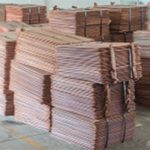Raw material
Raw material (electrolytic copper)
Specifications
Electrolytic copper: blister copper (99% copper) is preliminarily made into a thick plate as an anode, pure copper is used as a thin plate as a cathode, and a mixture of sulfuric acid and copper sulfate is used as an electrolyte. After energization, copper dissolves from the anode into copper ions (Cu) and moves toward the cathode. After reaching the cathode, electrons are obtained and pure copper (also called electrolytic copper) is precipitated at the cathode. Impurities in blister copper, such as iron and zinc, which are more active than copper, dissolve into ions (Zn and Fe) along with copper. Since these ions are less likely to precipitate than copper ions, it is possible to prevent these ions from being deposited on the cathode by appropriately adjusting the potential difference during electrolysis. Impurities such as gold and silver, which are inactive than copper, are deposited at the bottom of the electrolytic cell
Packing& Storage
| Packing | N/A | |||||||
| Storage | 20℃, 2 years. | |||||||
| Shipping | Room temperature in China; may vary elsewhere | |||||||
General Information
1.1 Chemical & Physical Properties
| Common Names | N/A | ||||||
| Structure | N/A | ||||||
| CAS No. | N/A | Boiling Point (℃) | N/A | ||||
| Molecular Weight | N/A | Melting Point (℃) | N/A | ||||
| Appearance | N/A | Vapor Specific Gravity | N/A | ||||
| HS Code | N/A | Flash Point (℃) | N/A | ||||
| Solubility | N/A | Autoignition Temperature (℃) | N/A | ||||
1.2 Safety Information
| Safety Phrases | N/A | |
| RIDADR | N/A | |
| WGK Germany | N/A | |
| Packaging Group | N/A | |
| Hazard Class | N/A | |
| SYMPTOMS | PREVENTION | FIRST AID | |
| Inhalation | Cough. Sore throat. | Use local exhaust or breathing protection. | Fresh air, rest. |
| Skin | Redness. Burning sensation. Itching. | Protective gloves. | Remove contaminated clothes. Rinse and then wash skin with water and soap. |
| Eyes | Redness. Pain. | Wear safety goggles. | First rinse with plenty of water for several minutes (remove contact lenses if easily possible), then refer for medical attention. |
| Ingestion | Abdominal pain. Nausea. Vomiting. | Do not eat, drink, or smoke during work. Wash hands before eating. | Rinse mouth. Induce vomiting (ONLY IN CONSCIOUS PERSONS!). Refer for medical attention . |
1.3 Synthetic Route
N/A
